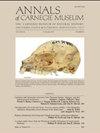Re-Description of the Auditory Region of the Putative Basal Astrapothere (Mammalia) Eoastrapostylops riolorense Soria and Powell, 1981. Systematic and Phylogenetic Considerations
IF 0.9
4区 地球科学
Q4 PALEONTOLOGY
引用次数: 15
Abstract
ABSTRACT Eoastrapostylops riolorense Soria and Powell, 1981, is a primitive meridiungulate mammal known by two specimens from the early Paleogene Río Loro Formation, in NW Argentina. The holotype and most complete specimen is an almost complete skull, mandible, and a few associated postcranial elements. Eoastrapostylops is one of the oldest South American ungulates with a well-preserved skull; although its original description included some cranial characters, its attribution to the endemic South American Order Astrapotheria and the concomitant phylogenetic consequences were based on dental features. New preparation and examination of the holotype (PVL 4216) revealed features not mentioned and/ or incorrectly interpreted in previous studies; particularly important are those of the auditory region. The cranial anatomy is here re-described and compared with that of Astrapotherium Burmeister, 1879, providing the first detailed description of a basal meridiungulate auditory region. The general structure of the preserved elements of E. riolorense resembles more closely that of archaic “ungulates” (i.e., condylarths) and litopterns than that of Astrapotherium or other astrapotheres with known skulls (e.g., Trigonostylops Ameghino, 1897, Astraponotus Ameghino, 1901); the more remarkable differences are: presence of distinct apertures (foramen ovale) for passage of the mandibular ramus of the trigeminal nerve, surfaces on the alisphenoid and squamosal for attachment of the ectotympanic bone, low and crest-like postglenoid process, postglenoid foramen medial to the postglenoid process and not piercing its base, almond-shaped promontorium with a strong caudal tympanic process almost obliterating the post-promontorial tympanic sinus, and the mastoid process exposed laterally and posteriorly. We performed three sets of cladistic analyses based on previously published matrices, including dental, cranial, and postcranial features scored in a wide sample of South American ungulates and archaic “ungulates.” The results suggest that Eoastrapostylops represents a basal meridiungulate lineage that diverged before the differentiation among astrapotheres, pyrotheres, and notoungulates, and thus it can be classified neither within Astrapotheria nor another clade of ordinal rank. Other groups of still uncertain status (e.g., Notopterna, Indalecidae) also would represent independent basal radiations, which would have characterized the early meridiungulate evolution, although this topic needs a more exhaustive exploration.基础黄芪(哺乳动物)听觉区域的重新描述(哺乳动物)oastrapostylops riolorense Soria and Powell, 1981。系统和系统发育的考虑
Eoastrapostylops riolorense Soria and Powell, 1981,是阿根廷西北部早古近纪Río Loro组的两个标本中已知的一种原始子脉哺乳动物。完整型和最完整的标本是一个几乎完整的头骨、下颌骨和一些相关的颅后器官。Eoastrapostylops是南美洲最古老的有蹄类动物之一,头骨保存完好;虽然其最初的描述包括一些颅部特征,但其归属于特有的南美星颅目及其伴随的系统发育结果是基于牙齿特征的。全新的全型(PVL 4216)制备和检查揭示了以前研究中未提及和/或错误解释的特征;听觉区域尤为重要。颅解剖在这里被重新描述,并与astapotherium Burmeister, 1879进行比较,提供了一个基底经脉听觉区域的第一个详细描述。相较于星甲目或其他已知头骨的星甲目(如Trigonostylops Ameghino, 1897, Astraponotus Ameghino, 1901),保存下来的E. riolorense元素的总体结构更接近于古代“有蹄类”(即,棘骨类)和石目;更显著的区别是:三叉神经下颌骨分支有明显的开口(卵圆孔),肋突表面和鳞状面附着于外鼓室骨,盂后突低且呈冠状,盂后孔位于盂后突内侧但未刺穿其基部,杏仁状的盂前突具有强大的尾侧鼓室突,几乎覆盖了盂后鼓室窦,乳突向外侧和后方暴露。我们根据先前发表的矩阵进行了三组进化分析,包括在南美有蹄类动物和古代“有蹄类动物”的广泛样本中得分的牙齿、颅骨和颅后特征。结果表明,黄芪甲是一个在黄芪甲、焦虫甲和无节肢动物分化之前就已经分化的基础子午节肢动物谱系,因此它既不能被归为黄芪甲,也不能被归为另一个序级分支。其他仍不确定地位的类群(如Notopterna, Indalecidae)也可能代表独立的基底辐射,这可能是早期经脉进化的特征,尽管这个主题需要更详尽的探索。
本文章由计算机程序翻译,如有差异,请以英文原文为准。
求助全文
约1分钟内获得全文
求助全文
来源期刊

Annals of Carnegie Museum
综合性期刊-动物学
CiteScore
2.50
自引率
18.20%
发文量
4
审稿时长
>12 weeks
期刊介绍:
Annals of Carnegie Museum is a quarterly journal that publishes peer-reviewed short and medium-length original scientific contributions in organismal biology, earth sciences, and anthropology, in 40 by 52.5 pica format (168 by 220 mm or 6-5/8 by 8-5/8 inches). Subject matter must be relevant to Carnegie Museum of Natural History scientific sections or Powdermill Nature Reserve (PNR), preferably with connection to the Carnegie collection and/or personnel. Carnegie Museum staff and research associates receive publication priority, but others are encouraged to submit papers, especially those manuscripts explicitly based on the Carnegie collection.
 求助内容:
求助内容: 应助结果提醒方式:
应助结果提醒方式:


